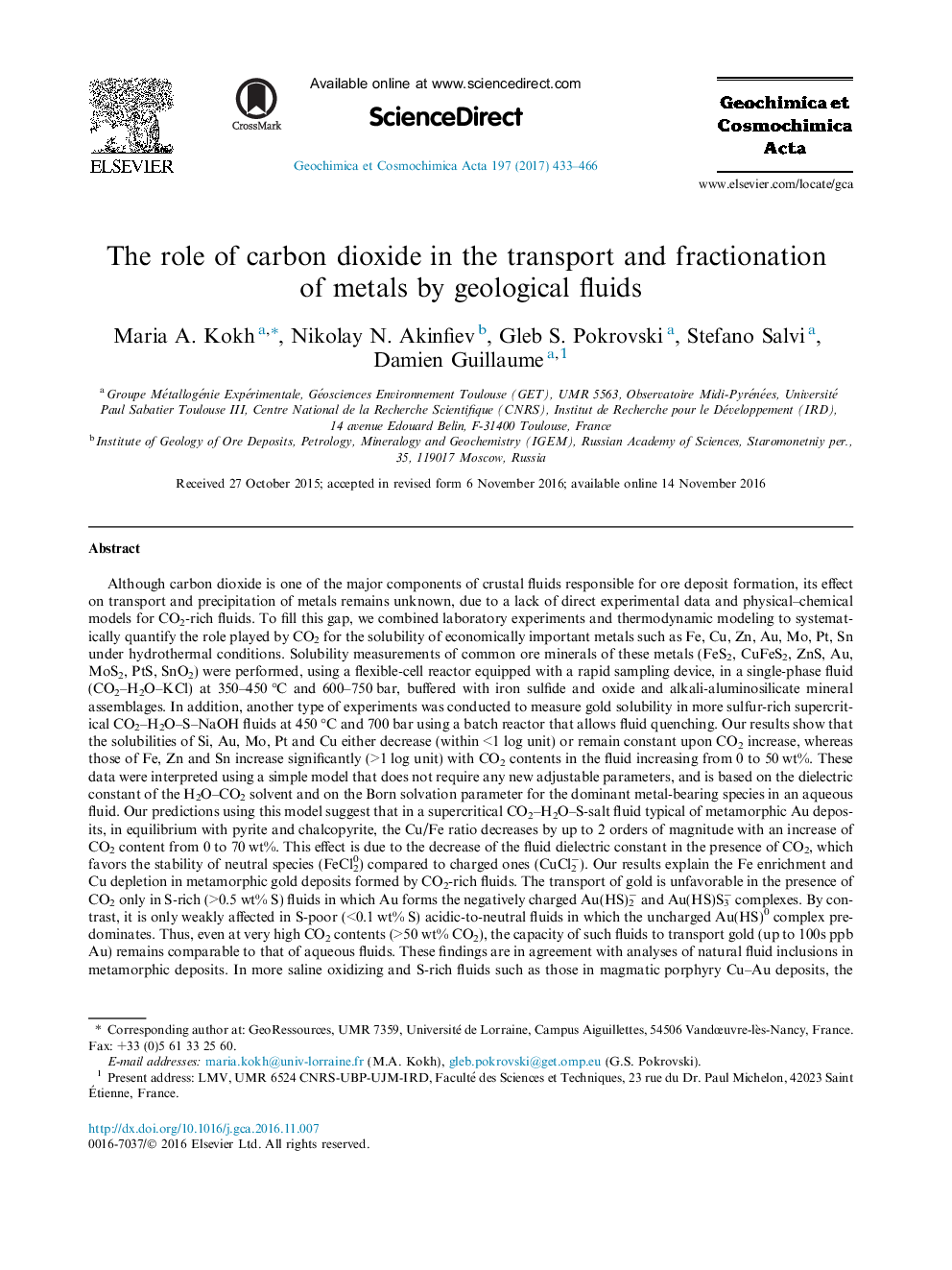| کد مقاله | کد نشریه | سال انتشار | مقاله انگلیسی | نسخه تمام متن |
|---|---|---|---|---|
| 8911071 | 1637960 | 2017 | 34 صفحه PDF | دانلود رایگان |
عنوان انگلیسی مقاله ISI
The role of carbon dioxide in the transport and fractionation of metals by geological fluids
ترجمه فارسی عنوان
نقش دی اکسید کربن در حمل و نقل و تجزیه فلزات با استفاده از مایعات زمین شناسی
دانلود مقاله + سفارش ترجمه
دانلود مقاله ISI انگلیسی
رایگان برای ایرانیان
کلمات کلیدی
دی اکسید کربن، فلزات، مایع فوق بحرانی، ثابت دی الکتریک، سپرده اوروژن سپرده پورفیر،
موضوعات مرتبط
مهندسی و علوم پایه
علوم زمین و سیارات
ژئوشیمی و پترولوژی
چکیده انگلیسی
Although carbon dioxide is one of the major components of crustal fluids responsible for ore deposit formation, its effect on transport and precipitation of metals remains unknown, due to a lack of direct experimental data and physical-chemical models for CO2-rich fluids. To fill this gap, we combined laboratory experiments and thermodynamic modeling to systematically quantify the role played by CO2 for the solubility of economically important metals such as Fe, Cu, Zn, Au, Mo, Pt, Sn under hydrothermal conditions. Solubility measurements of common ore minerals of these metals (FeS2, CuFeS2, ZnS, Au, MoS2, PtS, SnO2) were performed, using a flexible-cell reactor equipped with a rapid sampling device, in a single-phase fluid (CO2-H2O-KCl) at 350-450 °C and 600-750 bar, buffered with iron sulfide and oxide and alkali-aluminosilicate mineral assemblages. In addition, another type of experiments was conducted to measure gold solubility in more sulfur-rich supercritical CO2-H2O-S-NaOH fluids at 450 °C and 700 bar using a batch reactor that allows fluid quenching. Our results show that the solubilities of Si, Au, Mo, Pt and Cu either decrease (within <1 log unit) or remain constant upon CO2 increase, whereas those of Fe, Zn and Sn increase significantly (>1 log unit) with CO2 contents in the fluid increasing from 0 to 50 wt%. These data were interpreted using a simple model that does not require any new adjustable parameters, and is based on the dielectric constant of the H2O-CO2 solvent and on the Born solvation parameter for the dominant metal-bearing species in an aqueous fluid. Our predictions using this model suggest that in a supercritical CO2-H2O-S-salt fluid typical of metamorphic Au deposits, in equilibrium with pyrite and chalcopyrite, the Cu/Fe ratio decreases by up to 2 orders of magnitude with an increase of CO2 content from 0 to 70 wt%. This effect is due to the decrease of the fluid dielectric constant in the presence of CO2, which favors the stability of neutral species (FeCl20) compared to charged ones (CuCl2â). Our results explain the Fe enrichment and Cu depletion in metamorphic gold deposits formed by CO2-rich fluids. The transport of gold is unfavorable in the presence of CO2 only in S-rich (>0.5 wt% S) fluids in which Au forms the negatively charged Au(HS)2â and Au(HS)S3â complexes. By contrast, it is only weakly affected in S-poor (<0.1 wt% S) acidic-to-neutral fluids in which the uncharged Au(HS)0 complex predominates. Thus, even at very high CO2 contents (>50 wt% CO2), the capacity of such fluids to transport gold (up to 100s ppb Au) remains comparable to that of aqueous fluids. These findings are in agreement with analyses of natural fluid inclusions in metamorphic deposits. In more saline oxidizing and S-rich fluids such as those in magmatic porphyry Cu-Au deposits, the Fe, Cu, and Au solubilities in the presence of CO2 decrease by â¼1 order of magnitude with CO2 increasing to 20-30 wt%, following the decrease in the stability of their dominant charged species (FeCl42â, CuCl2â, Au(HS)2â and Au(HS)S3â), but stay almost constant at higher CO2 contents (30-70 wt%) as controlled by the neutral species (FeCl20, Cu(HS)0 and Au(HS)0). Such solubility trends suggest a new potential trigger of ore precipitation in porphyry systems by CO2 pulses from the magmatic chamber, which may operate along with commonly admitted depositional mechanisms such as cooling, vapor-brine immiscibility, and water-rock interaction. The direct effect of CO2 on the mobility of Pt and Mo, metals that likely form hydrogen sulfide and oxy-hydroxide complexes, respectively, is expected to be weak in most settings. Among the studied elements, Sn is the only one whose solubility may be favored at high CO2 content (>20 wt%) due to carbonate complexing. This study demonstrates, for the first time, that, contrary to common belief, the presence of CO2 in a supercritical fluid may lead to enhanced mobility or, on contrary, to massive precipitation of some metals, depending on salinity and sulfur content, and, more generally, to significant fractionations between different metals.
ناشر
Database: Elsevier - ScienceDirect (ساینس دایرکت)
Journal: Geochimica et Cosmochimica Acta - Volume 197, 15 January 2017, Pages 433-466
Journal: Geochimica et Cosmochimica Acta - Volume 197, 15 January 2017, Pages 433-466
نویسندگان
Maria A. Kokh, Nikolay N. Akinfiev, Gleb S. Pokrovski, Stefano Salvi, Damien Guillaume,
